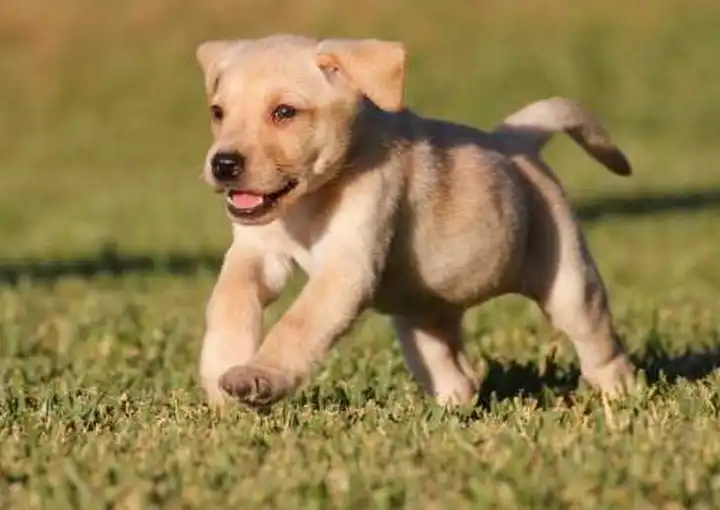As your puppy approaches 9 months of age, you may notice some changes in its behavior. At this age, puppies are entering adolescence, which means they may begin to exhibit some challenging behaviors. Understanding what is normal for a 9-month-old puppy behavior can help you address any issues and create a stronger bond with your furry companion.
How to Read Your 9-Month-Old Puppy’s Body Language

Your puppy may not be able to talk to you, but they communicate in other ways. By reading your puppy’s body language, you can comprehend their feelings and needs. Here are some tips for solving your 9-month-old puppy’s body language:
Tail Position
A puppy’s tail position can indicate its mood. A wagging tail typically means happy and excited, while a tucked tail can indicate fear or anxiety. If your puppy’s tail is straight up, it may feel confident or assertive.
Ear Position
Your puppy’s ears can also provide insight into their mood. If their ears are comfortable and pointing forward, they are likely feeling happy and curious. If their ears are pinned back, they may feel scared or anxious.
Vocalizations
Your puppy’s vocalizations can also show how they are handling it. Whining or whimpering may mean they are in pain or need attention, while growling or barking may mean they feel threatened or protective.
Body Posture
Understanding your 9-month-old puppy’s body posture is essential to sharing and addressing potential 9-month-old puppy behavior issues with them. Body language can convey various emotions and intentions, such as fear, anxiety, aggression, and happiness.
When observing your puppy’s body posture, tail, eyes, and overall view. Here are some typical postures and what they may indicate:
- Ears back, tail tucked, crouched body: Fear or anxiety
- Ears forward, tail wagging, relaxed stance: Happiness or excitement
- Ears flat against the head, tail low or tucked, staring eyes: Aggression or fear
- Stiff body, direct eye contact, raised tail: Aggression or dominance
- Yawning or licking lips: Stress or anxiety
Understanding your puppy’s body language can assist you in addressing potential 9-month-old puppy behavior issues before they escalate. For example, if your puppy exhibits fear or anxiety, you can address the issue by providing comfort and positive reinforcement.
It’s important to note that body language can vary depending on your puppy’s breed and temperament. Consulting with a professional dog trainer or behaviorist can provide additional guidance on solving your puppy’s body language and addressing 9-month-old puppy behavior issues.
Eye Contact
Your puppy’s eye contact can also provide insight into their mood. They will likely feel confident or powerful if they produce direct eye contact. They may feel scared or submissive if they avoid eye contact or turn their head away.
Reading your 9-month-old puppy’s body language is essential for any pet owner.
By knowing their tail position, ear position, vocalizations, body posture, and eye contact, you can comprehend their feelings and provide them with the care and attention they require. With practice and patience, you can develop a strong bond with your furry companion and secure their safety and love.
Common Issues 9-Month-Old Puppy Behavior Puppies and How to Address Them

Common issues in 9-month-old puppy behavior can frustrate pet owners, but they can be effectively addressed with the right training methods and toys.
Destructive chewing
One common issue is destructive chewing, where puppies may chew on furniture, shoes, or other household items. This 9-month-old puppy behavior can be addressed by providing appropriate chew toys and regularly rotating them to keep your puppy engaged. Toys specifically designed for chewing, such as durable rubber toys or nylon bones, can help redirect your puppy’s chewing behavior and prevent damage to your home.
Separation Anxiety
Another common issue is separation anxiety, where puppies may become anxious or distressed when left alone. It can address by gradually increasing your puppy’s time alone, starting with short intervals and gradually building up to longer periods. Providing your puppy with interactive toys, such as a puzzle or treat-dispensing toys, can also help keep them occupied and reduce anxiety when alone.
Potty training
Potty training is another common issue, but it can be effectively addressed using positive reinforcement techniques, such as rewarding your puppy for going potty in the right spot and using consistent verbal cues. Additionally, using a crate or confinement area can help establish a routine for your puppy and prevent accidents.
Jumping
Jumping is a common 9-month-old puppy behavior issue in young puppies. To address this behavior, ignore your puppy when they jump up and only give attention when they are on the ground. Consistent training and positive reinforcement can also help teach your puppy to greet people politely.
Barking
Puppies may bark to get attention or express excitement, but excessive barking can become a nuisance. To address this 9-month-old puppy behavior, identify the trigger for your puppy’s barking and provide appropriate outlets for their energy and excitement. Consistent training and positive reinforcement can also help teach your puppy to bark only when necessary.
Leash Pulling
Leash pulling can make walks stressful and unpleasant for you and your puppy. Use a properly fitted harness and practice loose-leash walking techniques to address this behavior. Consistent training and positive reinforcement can also help teach your puppy to walk calmly on a leash.
Understanding the science behind these training methods and toys is important to make them more credible and effective. Positive reinforcement techniques are more effective than punishment-based methods, as they encourage desired 9-month-old puppy behavior and build a stronger bond between the pet and owner. Additionally, toys designed to meet a puppy’s chewing needs can redirect destructive behavior and provide mental stimulation.
By understanding the science behind these training methods and toys, pet owners can effectively address common 9-month-old puppy behavior issues in their 9-month-old puppies and build a healthier relationship with their furry friends.
The Importance of Positive Reinforcement in Training Your 9-Month Old Puppy

As a training methodology, positive reinforcement emphasizes the reward for good behavior instead of punishment. It is understood to be more practical and humane than alternative training methods.
There are several reasons why positive reinforcement is essential in preparing your 9-month-old puppy’s behavior.
Builds Trust and Confidence
it allows for building trust and confidence between you and the puppy. By awarding good behavior, your puppy trusts and respects you as its leader, boosting its confidence in understanding and completing tasks.
Creates a Positive Learning Environment
positive reinforcement creates positive learning conditions for your puppy. When you cite acceptable behavior, your puppy is more inclined to repeat such behavior in the end, showing a cycle of positive reinforcement that encourages your puppy to continue understanding and enhancing its behavior.
Increases Motivation and Engagement
Knowing that good behavior choices are cited, your puppy can participate actively in exercise sessions and work to discover new manners.
Reduces Stress and Anxiety
Fourthly, It assists in relieving stress and anxiety in your puppy. When punishment-based training techniques are employed, your puppy may become nervous and fearful of making mistakes, leading to a negative learning experience and a breakdown in confidence and bond.
Improves Overall Behavior and Relationships
Lastly, improves overall 9-month-old puppy behavior and relationships with you, different individuals, and beasts. You teach your puppy to behave positively and respectfully by citing good behavior and building a strong and loving relationship.
Socialization

Socialization is a highly important process during a puppy’s formative months. At the ripe age of nine months, your little furry friend is still in the nascent stages of learning how to interact with other dogs and people.
Good socialization of your puppy can aid in controlling behavior issues, such as fear, attack, and anxiety. A gradual process of exposure, beginning with friendly individuals and pets and gradually advancing to new adventures and conditions, is necessary.
Avoid coercing your little one into uncomfortable conditions, which can cause fear and anxiety, is paramount. Socialization must continue throughout your pet’s life to maintain social skills and control behavior issues. If you require additional guidance on socialization techniques for your 9-month-old puppy, do not hesitate to consult your veterinarian or an experienced puppy trainer.
Training
Training is a fundamental aspect of owning a 9-month-old puppy. It is through training that your little furry friend learns practical life talents such as proper behavior in various conditions, following essential bases, and interacting with other individuals and animals.
Different methods can be taken when it reaches to teaching your puppy. Positive reinforcement activity, as mentioned in the previous article, is one approach that concentrates on awarding acceptable behavior instead of penalizing poor behavior, resulting in an effective, humane, and beneficial outcome for both the puppy and the owner.
Clicker training is another well-known approach that uses a clicker to signal your pup when they have done something perfectly, citing them with a treat. This technique is founded on the regulations of operant conditioning and is useful in training new behaviors and supporting the right behavior.
Consistency is essential when it reaches to training your little companion. Selecting exact directions and anticipations and consistently enforcing them allows your pup to comprehend what is anticipated of them and what behaviors are inappropriate.
Energy Levels

At 9 months old, your puppy is likely still very energetic and playful. They may have bursts of energy followed by periods of rest. It’s important to provide plenty of exercise and playtime for your puppy to help them burn off excess energy. Without adequate exercise, they may become bored and destructive.
Understanding your 9-month-old puppy’s energy levels is crucial to providing them with the appropriate physical and mental stimulation they need. Your puppy may have high energy levels at this age, requiring regular exercise and playtime to keep them happy and healthy.
It’s important to note that different breeds have different energy levels, so it’s essential to research and understands what type of exercise and activities suit your puppy. For example, high-energy breeds like border collies may require more intense exercise than low-energy breeds like bulldogs.
In addition to regular exercise, mental stimulation is essential for a 9-month-old puppy. Giving your puppy puzzles and toys that challenge them mentally can help prevent boredom and destructive behavior.
It’s important to remember that your puppy’s energy levels may fluctuate throughout the day, and they may have bursts of energy followed by periods of rest. Monitoring your puppy’s behavior and adjusting its exercise routine is essential.
If your puppy has excess energy and exhibits destructive behavior, it’s important to assess their exercise and mental stimulation routine and adjust it accordingly. Consult your veterinarian or a professional dog trainer if you need additional guidance.
Understanding and managing your 9-month-old puppy’s energy levels is essential to their health and well-being. Regular exercise and mental stimulation can help them stay happy, healthy, and well-behaved.
Conclusion
It is essential to note that understanding your 9-month-old puppy behavior is crucial in providing that it grows into a well-behaved and happy adult dog. Providing plenty of practice and playtime, telling them about new adventures, addressing behavior issues early, and using positive reinforcement exercise techniques with patience and consistency, can help your puppy navigate its adolescent months and become a beloved family member for years.



